25th Anniversary of UNESCO World Heritage Site
Issue date: 24th March 2020
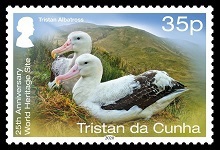 |
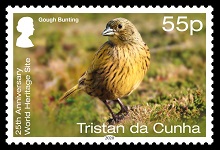 |
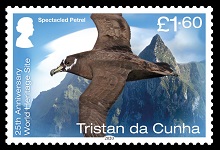 |
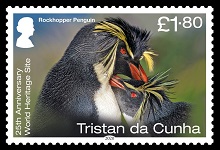 |
| 202001 | Mint Stamps (35p, 55p, £1.60, £1.80) | £4.30 |
| 202002 | First Day Cover (with 35p, 55p, £1.60, £1.80 stamps) | £5.30 |
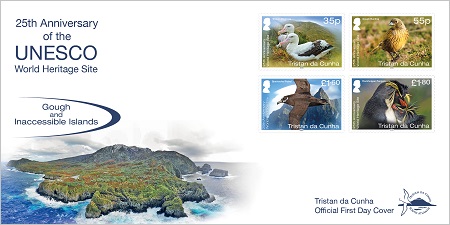
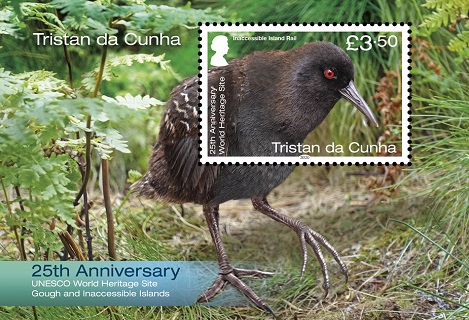
| 202003 | Souvenir sheetlet with £3.50 stamp | £3.50 |
| 202004 | First Day Cover with £3.50 souvenir sheetlet | £4.50 |
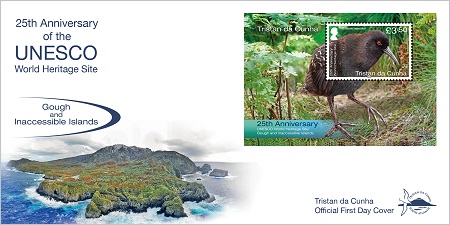
Gough Island and Inaccessible Island are in the archipelago of Tristan da Cunha in the South Atlantic Ocean, and form part of one of the United Kingdom's most remote Overseas Territories.
The islands were formed through volcanic eruptions. Gough's 65km2 landscape is rugged, with rocks up to 6 million years old making up the cliffs that reach heights of 300m along the coastline. All but the steepest rock faces are covered in vegetation – mainly lichens, mosses and ferns.
Uninhabited, both islands developed almost free from human interference, making them some of the least disturbed habitats left on earth. Their isolation means they have also become home to unique arrays of plants and animals.
Precious habitats
Gough Island is widely considered one of the world's most important seabird nesting sites, with 22 species of nesting seabirds, and 2 land bird species that are 'endemic' – in other words, unique to this location. 7 species on Gough are globally threatened, including virtually the entire world population of the Tristan albatross and most of the world's examples of MacGillivray's prion. 3 species on Inaccessible are globally threatened – the spectacled petrel, Inaccessible rail and Inaccessible bunting; the latter two are also endemic to Inaccessible.
The Southern elephant seal and Sub-Antarctic fur seal both breed on Gough, and 85% of the world's Northern rockhopper penguins nest in the Tristan da Cunha archipelago. The two islands are also home to significant plants, ferns, snails and beetles.
Global recognition
The islands' listing as a World Heritage Site began in 1995 in recognition of their rich biodiversity, their importance for breeding seabirds, and the presence of endemic species. They are therefore listed for their Outstanding Natural Universal Heritage – one of only four natural World Heritage Sites in the UK's worldwide realm.
The decision noted that the site meets the criteria 'as one of the least disturbed major cool-temperate island ecosystems in the South Atlantic, one of the most important seabird colonies in the world and high scenic qualities with spectacular sea-cliffs'.
In 2004 the WHS boundary was extended to include Inaccessible Island and the waters surrounding the islands to 12 nautical miles, and the site name was changed to Gough and Inaccessible Islands.
The listing of a WHS gives the 'State Party' (in this case, the United Kingdom) legal obligations to ensure the identification, protection, conservation, presentation and transmission to future generations of the cultural and natural heritage of the site (and others in its territory). Specifically, 'It will do all it can to this end, to the utmost of its own resources and, where appropriate, with any international assistance and co-operation, in particular, financial, artistic, scientific and technical, which it may be able to obtain.' It's an important obligation on the UK to maintain the natural heritage that led to the designation, to take appropriate measures to achieve this, and to rehabilitate the site.
See the relevant full UNESCO World Heritage Site listing at: https://whc.unesco.org/en/list/740.
Under attack
Sadly, Gough Island's natural value, and so too its WHS status, is under threat. Invasive non-native mice brought to the island by sealers around 200 years ago are attacking the island's native and globally threatened seabirds. With so many unique species on Gough, extinction from the island would mean extinction globally. Loss of the biodiversity that won Gough its WHS status would mean it no longer meets the required criteria for a site of Outstanding Universal Value.
In 2016 an assessment of the islands for their inclusion on the WHS 'In Danger' list concluded that eradication of invasive non-native mice is necessary to protect Gough's unique species, and its WHS status. Led by the RSPB and Tristan da Cunha Government, an operation to eradicate the mice and restore Gough Island is set to take place in 2020 – the 25th anniversary year of the Gough and Inaccessible World Heritage Site. If the plan succeeds, species will begin to recover almost immediately as they return to nest on an island free of invasive mice.
For more information on this project see: https://www.goughisland.com/
Stamp Design Details
| 35p | - |
Tristan Albatross (Diomedea dabbenena) This albatross is endemic to the Tristan group. Its main breeding site is Gough Island, with the occasional pair on Inaccessible Island. It no longer breeds on Tristan island. |
| 55p | - |
Gough Bunting (Rowettia goughensis) This large critically endangered bunting is endemic Gough Island, where it occurs in all habitats from boulder beaches to the highest peaks. It has a long slender beak, and a varied diet of invertebrates, fruits, seeds and even carrion. |
| £1.60 | - |
Spectacled Petrel or Ringeye (Procellaria conspicillata) This dark petrel gets its name from the characteristic rings of white markings around its eyes. It breeds on Inaccessible Island in large muddy burrows on the island plateau, but forages throughout the temperate South Atlantic. |
| £1.80 | - |
Rockhopper Penguin (Eudyptes moseleyi) There are several species of Rockhopper Penguin that breed on the southern islands of the Atlantic, Indian and Pacific Oceans. The Tristan group is home to the Norther Rockhopper Penguin, where it breeds on all the islands. They are a common sight on Tristan island, and sometimes moult in village gardens. |
| £3.50 | - |
Inaccessible Island Rail (Atlantisia rogersi) This is small flightless rail, which, as its name indicates, is endemic to Inaccessible Island. It is found in all habitats, but is usually hard to see as it keeps under cover. |
| FDC | - |
South Coast of Gough Island Aerial view of the south of Gough Island with (to the left) the meteorological station operated by the South African National Antartic Programme (SANAP). It is also used as a base by visiting scientists. |
Technical Specifications from Pobjoy Mint Ltd.
| Photography: | 35p, 55p - Michelle Risi £1.60 - Andy Schofield £1.80 - Jaimie Cleeland FDC - Chris Jones |
Designer: | Andrew Robinson |
| Printer: | Cartor Security Printing | ||
| Stamp size: | 42 x 28mm | Souvenir sheet size: | 94 x 64mm |
| Process: | Lithography | Perforation: | 13¼ x 13 per 2cms |
| Production Co-ordination: | Creative Direction (Worldwide) Ltd | Layout: | 10 |
